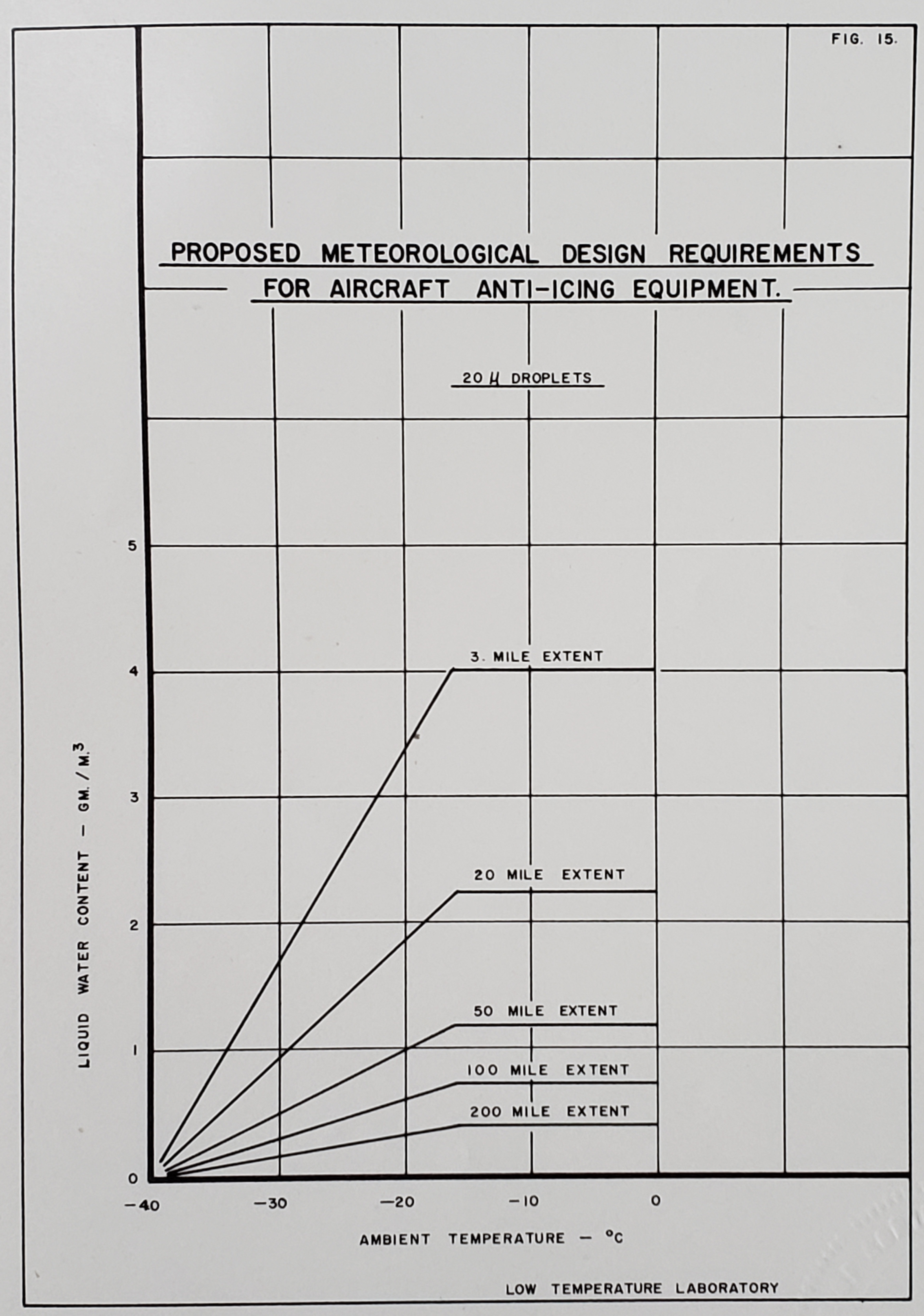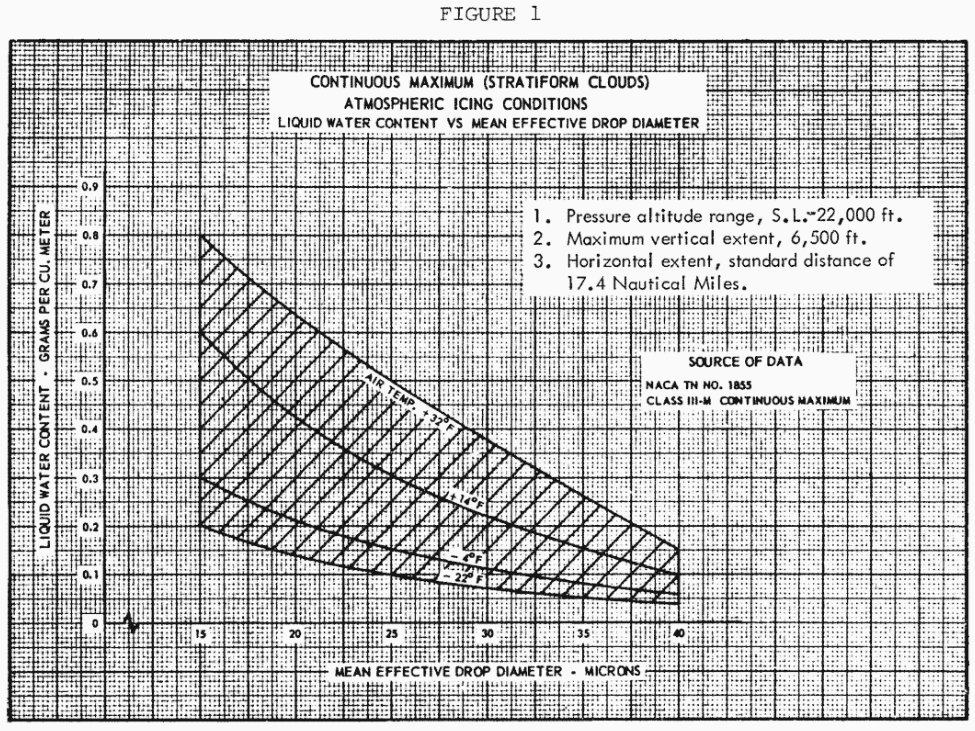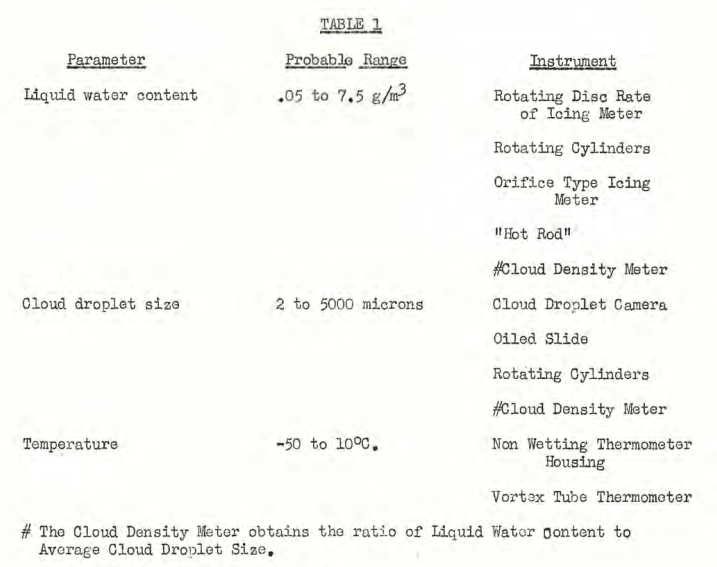"It is observed that severe icing is not predicted over large areas."
Introduction
This is one of the shortest post that I have written, as it is more outlining a mystery, that I have not yet sorted out, than a full review.
Summary
In Conclusions of the Meteorology of Icing Clouds Thread, there is a time-line of how the NACA understanding of the icing conditions evolved, focussing on liquid water content (LWC) values.
In Canada, icing research was also being performed by the National Aeronautical Establishment (NAE).
Here, we will compare what was published in the University of Michigan Airplane Icing Information Course, in 1953, to NACA data and the later Appendix C.
Discussion
Smith, E. L.: "The Design of Fluid Anti-Icing Systems" (NAE) 1
3.3 Meteorological Conditions
Figure 15 presents the meteorological design requirements proposed by the Low Temperature Laboratory of the N.A.E. It is observed that severe icing is not predicted over large areas. These curves may be cross plotted on fluid requirement curves (for example, Figures 7 to 10), assuming constant meteorological conditions to 20,000 ft., to determine the fluid requirements at various flight speeds and altitudes. If a control for fluid flow is provided, then the 3-mile extent curve will simply specify the maximum flow required, while the lower curves enable a prediction to be made of the maximum total quantity of fluid required for a given flight.

Fraser, Don: "Meteorological Design Requirements for Icing Protection Systems" (NAE) 2
Fraser compares the NAE definition to the NACA values:

Drop size information is given in Section 4.4. Figure 11b is referenced (not included here) which indicates the use of 35 micrometer volume median drop diameter at an LWC value of 2 g/m^3. [This is from the errata sheet, the original text used Figure 7.] A size distribution is recommended that "corresponds roughly to the Langmuir and Blodgett Spectrum 'C'".
Fraser Figure 12 has a separate line for freezing rain.
Comparison to an Appendix C icing condition
As we did in Conclusions of the Meteorology of Icing Clouds Thread for data from several sources, we will see what LWC value this definition (designated as "N.A.E.") yields for a selected condition, Appendix C 3 Figure 1 for "Continuous Maximum (Stratiform Clouds)" (upper left corner of the envelope):
- Temperature = 32F, MVD = 15 micrometer, 17.4 nmi (20 mile) extent

The differing MVD value for the NAE definition makes this a bit of a strained, "apples and oranges" comparison, but I will also include the Appendix C values for 35 micrometers.
| Source | Year | LWC, g/m^3 |
|---|---|---|
| Rodert | 1946 | 3.0 |
| NACA-TN-1391 | 1947 | 1.5 |
| NACA-TN-1393 | 1947 | 0.8 |
| NACA-TN-1424 A | 1947 | 1.0 |
| NACA-TN-1424 B | 1947 | 0.8 |
| NACA-TN-1855 | 1949 | 0.8 |
| N.A.E. | 1953 | 2.25 [30 MVD] |
| CAR 4b-2 (1964 Appendix C) | 1955 | 0.8 [15 MVD] |
| CAR 4b-2 (1964 Appendix C) | 1955 | 0.26 [35 MVD] |
This is a much different value than what NACA was converging on. Fraser cites NACA-TN-1855 (and NACA-TN-2569 and NACA-TN-2738), so at least some in the NAE were aware of them.
Oleskiw 5 summarizes the flight tests and instruments used.
As we saw in the Conclusions of the Meteorological Instruments Thread, the National Research Council (Canada) had arrived at a similar instrumentation suite to that used by NACA by 1952 6.

So, differences in instruments does not appear to be an explanation for the strikingly different results.
Conclusions
I have not been able to find the actual data that the NAE used to determine the values.
The NAE publications show a diversity of opinions in 1953 about what icing design conditions should be compared to the NACA publications.
Notes
-
Smith, E. L.: "The Design of Fluid Anti-Icing Systems". Engine Laboratory, National Aeronautical Research Establishment, Ottawa, Canada, Lecture No. 11, University of Michigan Airplane Icing Information Course, 1953. (32 pages) (includes errata sheet) ↩
-
Fraser, Don: Meteorological Design Requirements for Icing Protection Systems. Low Temperature Laboratory, NAE, Ottawa, Canada, Lecture No. 12a, University of Michigan Airplane Icing Information Course, 1953. (36 pages) ↩
-
“Airworthiness Standards: Transport Category Airplanes”, CFR 14, Part 25, Appendix C, Washington, DC, 2021 Appendix C ecfr.gov ↩
-
"AIRPLANE AIRWORTHINESS - TRANSPORT CATEGORIES MISCELLANEOUS AMENDMENTS", Civil Air Regulations Amendment 4b-2, July, 1955. stacheair.com ↩
-
Oleskiw, M. M. "A review of 65 years of aircraft in-flight icing research at NRC." Canadian Aeronautics and Space Journal 47.3 (2001): 259-268. researchgate.net ↩
-
Pettit, K. G.: "'The Rockcliffe Ice Wagon' and its role in Canadian icing research." Publ. R. Met. Soc. Canad. Branch, Toronto 2 (1951). cmosarchives.ca ↩